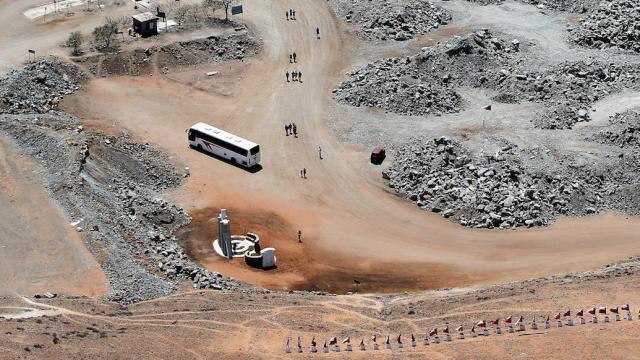It’s been almost four years since 33 Chilean miners were trapped below the surface of the earth for 69 days. A story published this week by The New Yorker reveals some additional stunning details about their harrowing rescue, and some astounding new information about the mine itself.
As part of his forthcoming book Deep Down Dark, Writer Héctor Tobar takes us inside the ill-fated San José Mine, a subterranean city carved out throughout the decades where temperatures would reach up to 40C with 98 per cent humidity. It was also a place that was known to be dangerous: Injuries and accidents had plagued the mine long before the 2010 incident, and safety systems that were promised were never installed. Here are a few of the more jaw-dropping facts gleaned from the article.
The mine itself was almost as deep as world’s tallest building.
It was a mine as deep as the Burj Khalifa is tall: 163 storeys. To get to the bottom, you would drive down a 6km road — named the Ramp — which corkscrewed into the space with enough room for multiple vehicles (it had actual traffic signs). The mine was literally an underground skyscraper, with rooms and hallways and “floors” measured by their distance from sea level: The entrance was Level 800 (800m above sea level), the miners were trapped in a space around Level 90, 700m below the surface. The fragment of rock that fell into the mine, creating the collapse that trapped the miners inside, was 45 storeys tall: “It was later estimated to weigh seven hundred thousand tons, twice the weight of the Empire State Building.”
The miners spent 10 weeks in a small room called The Refuge.
The Refuge was the place the miners were supposed to go in case of an emergency. It was “classroom-sized” and had a white tile floor, a cinder-block wall, and a steel door, which blew open in the explosion. The electricity, intercom, and access to fresh air and water had all been severed. There were enough provisions to keep 25 men alive for 48 hours: “One can of salmon, one can of peaches, one can of peas, eighteen cans of tuna, twenty-four litres of milk (eight of which turned out to be spoiled), ninety-three packages of cookies, minus the ones that had been eaten, and some expired medicines. There were also two hundred and forty plastic spoons and forks, but only ten litres of bottled water.” They ended up drinking from the tanks of industrial water tainted with oil.
They used what little technology they had to survive.
Even though they were trapped far beneath the earth, they still managed to use the technology around them to stay alive. The miners were able to save (physical) energy by driving their vehicles to haul water from various levels of the mine. One of the miners used a cell phone to record videos of themselves. At first they were worried about being left in complete darkness — which they believed would make them blind — but they were able to charge their headlamp batteries using the generators of the trucks. Once the drill broke through from the surface, the rescue teams sent down a video camera and a telephone receiver to communicate with the world above ground, and a projector so the miners could watch videos of themselves as global heroes.
Read the whole story as soon as you can, it’s absolutely incredible. [New Yorker]
Picture: Dean Mouhtaropoulos / Getty Images
